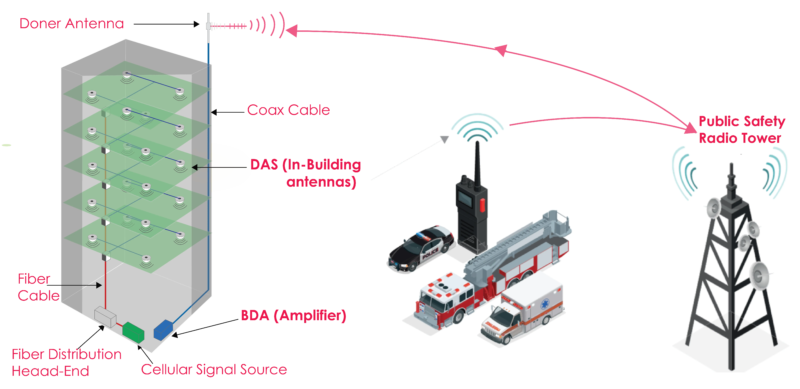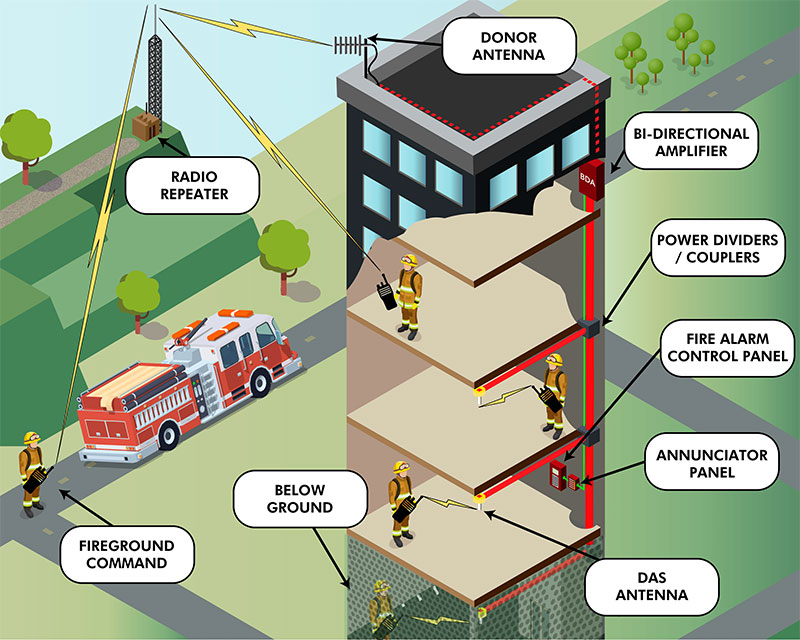In-Building Solutions Overview

ERCES (Emergency Responder Communication Enhancement System)
What you need to know:
An In-Building Emergency Responder Communications Enhancement System (ERCES) is a wireless communications system used by first responder and emergency services personnel, such as police, fire, emergency medical, homeland security, and disaster response agencies. First responder communications capabilities are a critical component of every emergency response that takes place within a building.
When emergency responders enter a building their ability to maintain inter-operable and continuous communications is paramount to the protection of both public safety and the public’s safety. An In-Building ERCES ensures that communication signals can penetrate into all areas of buildings, using DAS, in accordance with model fire codes and standards. This includes areas that are especially difficult for Radio Frequency (RF) to penetrate, such as exit stairwells, occupant use elevators, basements, buildings with Low-E glass, garages, thick-walled or other areas shielded with various types of building materials. Having an RF Grid test can help determine if such a system will be essential.
We customize each aspect of these systems to ensure the best quality of RF coverage and the seamless integration of each new system. Our solutions improve connectivity in areas that have compromised (dead zones) radio or carrier signal coverage.
Lets break it down:
NFPA & ICC Codes:
The need for in-building wireless communications for Emergency Responders resulted in the development of national model codes by the National Fire Protection Association (NFPA) and the International Code Council (ICC) as early as 2009. The NFPA and ICC national level model in-building code development is being driven primarily by fire service jurisdictions. However, the requirements for emergency responder communications coverage are designed to include all public safety agencies, including law enforcement and emergency medical services. The NFPA and ICC initiatives are separate but complementary. While the precise provisions of the model codes may vary slightly between the two code development groups, key specifications involve significant commonality across the two initiatives. In addition, local jurisdictions may include code modifications (additions and/or deletions) from the national level model code framework. In other words: Each jurisdiction may “customize” the national level model codes to meet any unique local requirements.
BDA: Bi-Directional Amplifiers. A system that extends two-way radio coverage into difficult-to-reach areas, such as stairwells, underground hallways, tunnels, parking garages, and other challenging zones.

DAS: Distributed Antenna Systems. A group of antennas placed throughout the structure to boost signal coverage.
Active DAS:
Active DAS simply means the components require a power source to operate. Building owners, property managers, and enterprise customers have a number
of options when there’s a cellular coverage problem. Traditionally, so-called Active Distributed Antenna Systems (DAS) were the only alternative for many
customers. These systems are expensive and take months to deploy, although for customers with capacity issues (think football stadium or airport) it is the preferred solution. Permission to connect to a carrier network is often a long, time-consuming process. For each additionally carrier, the process has to be repeated each time.
Active DAS solutions are costly and can take several months up to a year to install. As a rule of thumb, any high-traffic building over 500,000 sq. ft. needing complete wall-to-wall coverage should consider Active DAS.
Passive DAS:
Passive DAS systems tend to use passive components like coaxial cable, splitters, and diplexers to distribute signal, and unlike active DAS, they use bi-directional amplifiers to re-broadcast signal from a macro cellular network using either an over-the-air donor antenna or a “small cell” from each carrier. This means that Passive DAS heavily rely on adequate signal from a nearby celltower – a great solution for urban areas. For a complete Passive DAS installation, the total cost is greatly less expensive than Active DAS and the time required installing ranges from days to a few weeks or months.
Passive DAS is the best choice for buildings up to 100,000 square feet, but can also be scaled upwards to 500,000 square feet. A Passive DAS is much more cost-effective and can provide appropriate cellular coverage in most commercial buildings.
